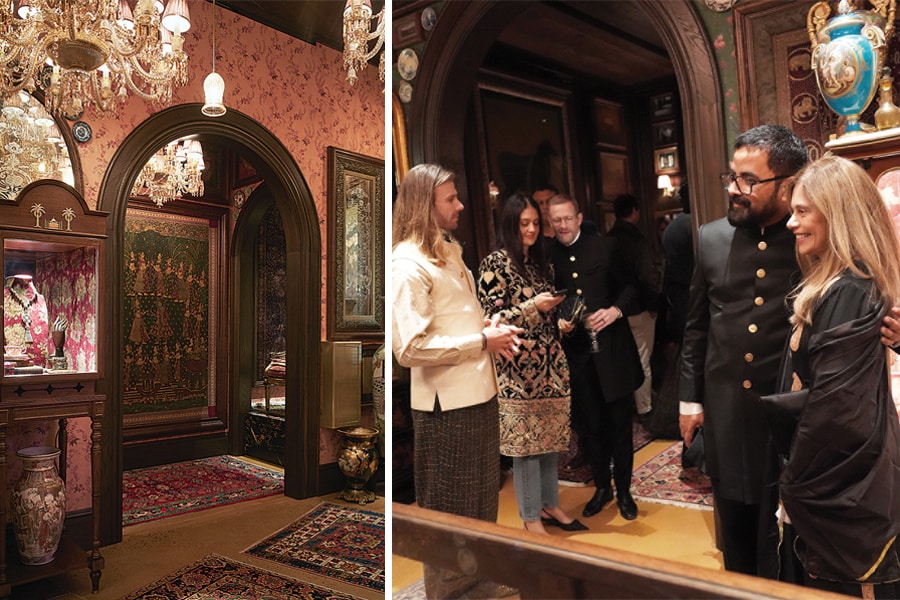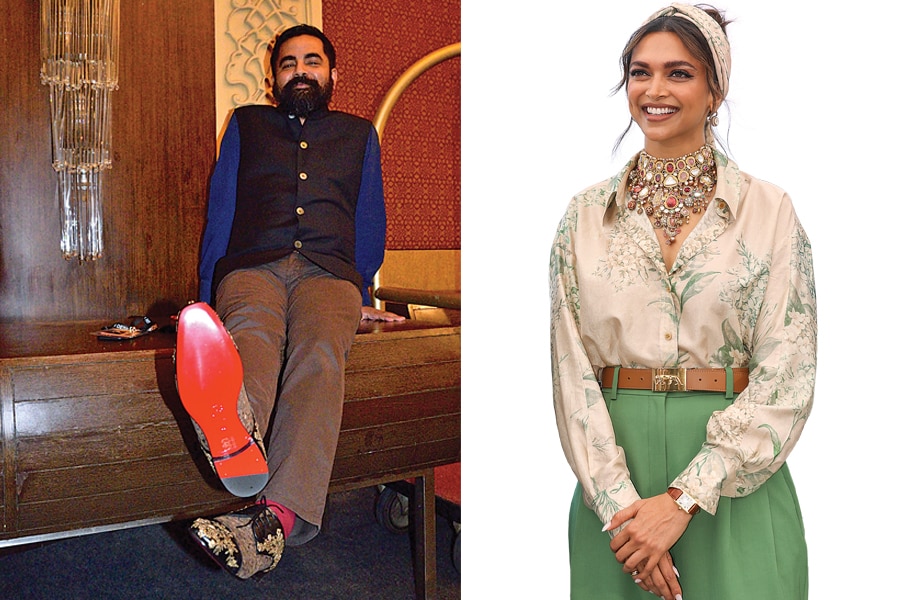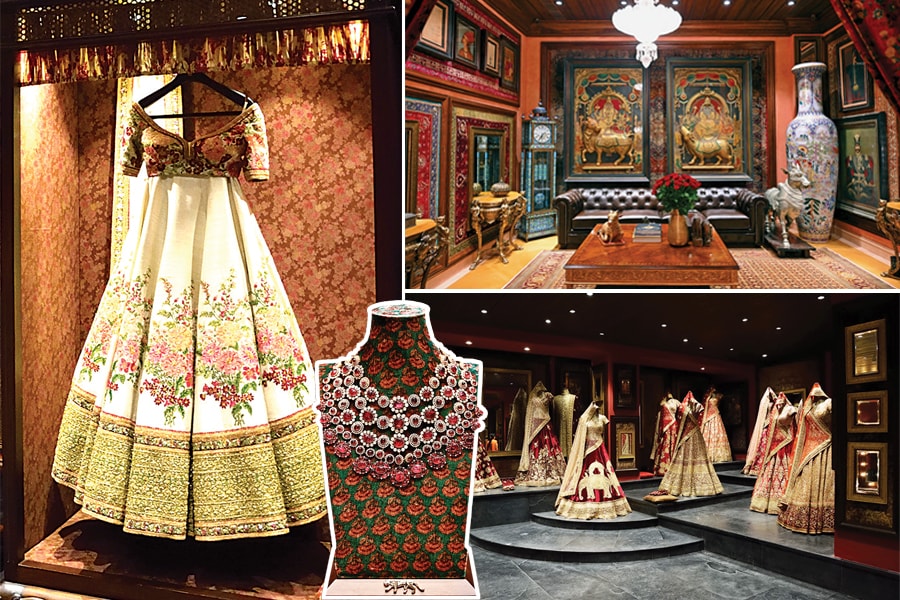Sabyasachi wants to drape the world in his hues
Sabyasachi Mukherjee's passion for Indian craft and heritage has always been the heart of his brand's identity. Now an extension of this is his desire to break into the elite club of global fashion ho


“Should I wear blue or black?" he asks. I am caught by surprise. Because the person asking the question is the man behind many a style icon. He has built India’s leading luxury house ground up, and is the ruler of a growing global empire. But his simplicity is not typical of someone of his star status.
A sought-after fashion designer—whose client list includes the crà¨me de la crà¨me of elite society—with a middle-class upbringing, Sabyasachi Mukherjee isn’t pretentious, and hasn’t lost the common touch. Walking barefoot in his plush bungalow, he exudes an easy charm, a far cry from his reputation of being a reserved intellectual.
I’m inside Mukherjee’s beautiful house in Kolkata. His home layout and interiors, painstakingly designed by him over nearly three years, are a mix of traditional opulence—reminiscent of old palatial mansions of Calcutta—with a modern touch of stylish patios and manicured lawns. Mukherjee’s fondness for art and literature is evident in every nook and corner. From rare texts of Rabindranath Tagore to the very first edition of The Jungle Book, Mukherjee is a proud collector of books and objet d’art. Everything—from the rugs to the chandeliers—aesthetically blends into the luxurious setting.
A perfect host, Mukherjee, at the core, is a man who is proud of his humble roots of Calcutta. His passion for Indian craft and heritage is the heart of his brand’s identity. An extension of this is his desire to break into the elite club of global fashion houses to authentically showcase India’s unique and rich cultural legacy worldwide. “I want to create a global business, bring foreign currency into India, and allow Indian craft to thrive," he tells Forbes India days before the Durga Puja festival. “Many luxury brands should emerge from India and stand tall with American brands." This is his pursuit. “If I fail, some other Indian will succeed to do so, but the writing is on the wall," he adds.
 Sabyasachi Mukherjee launched his first international flagship store in New York in October. The designer plans to open many more across the worldImage: Sonia Moskowitz /Getty Images
Sabyasachi Mukherjee launched his first international flagship store in New York in October. The designer plans to open many more across the worldImage: Sonia Moskowitz /Getty Images
Taking this goal a step further, Mukherjee launched his first international flagship store in New York in mid-October that took around two-and-a-half years to build. “It is an incredible store. I don’t think the US has ever seen retail like this in its history. There is so much that India has to offer to the world," he says. The flagship store is one among the many he plans to roll out across the world. The collection will always be inspired by India’s legacy of fine craftsmanship, but the silhouettes will cater to western preferences. “You can put Indian zardozi on jackets instead of ethnic wear," he explains.
Over the years, House of Sabyasachi has inked several pacts and extended its offerings beyond traditional clothing. Some important global collaborations include partnerships with Christian Louboutin and Bergdorf Goodman, to name a few. With Aditya Birla Fashion Retail on board as a strategic investor, ‘Sabyasachi’ is looking to expand its market and enter new segments. Around five years ago, the luxury house made a splash with the launch of its jewellery collection. The regal designs crafted with diamonds, gold and gems tried to cut into the unorganised jewellery market in India.
‘Sabyasachi’ launched its trademark belt for the retail market about three years ago. At last count, until last year, over 10,000 belts were sold. Mukherjee struck gold with the launch of handbags too. The average wait list for a Sabyasachi bag can be up to two-and-a-half months. In fact, Sabyasachi’s appetite for foraying into new areas is growing. “I plan to enter the food and hospitality space, home interiors is also an area of interest. The world is my oyster," he says. Over the next five years, the ace designer-cum-businessman aims to direct and produce films too. “Will do them bit by bit," he assures.
 Mukherjee and Lebanese shoe designer Christian Louboutin collaborated on a couture line. The designer with their famous red-soled shoes at the 2015 Amazon India Couture Week actor Deepika Padukone (right) wears a Sabyasachi belt Image: Rubina A. Khan / Getty Images Stephane Cardinale / Corbis Via Getty Images (Deepika)
Mukherjee and Lebanese shoe designer Christian Louboutin collaborated on a couture line. The designer with their famous red-soled shoes at the 2015 Amazon India Couture Week actor Deepika Padukone (right) wears a Sabyasachi belt Image: Rubina A. Khan / Getty Images Stephane Cardinale / Corbis Via Getty Images (Deepika)
This isn’t an exaggeration for someone who has moved off the beaten path for over two decades to build a luxury brand of global repute. Born in a small town opposite the Hooghly River in West Bengal, Mukherjee had a fairytale childhood. “What we lacked in money we made up with imagination," he reminisces. By 18, he had never been on a plane or travelled outside the state. “Calcutta, for me, was Paris. It was fascinating," he says. A good student, his parents were confident he would be a doctor or an engineer. He was miles away from the glamour of the fashion world. Yet destiny had other plans.
A quick learner, Mukherjee learnt the ropes of the trade, and identified his astute business instincts and flair for design. But how does one sell to a customer whose lifestyle is alien to you? This marked Mukherjee’s struggle for the first couple of years. “For me, a big challenge was how do you create a business of rich people who live a life of privilege when I as a middle-class boy had never seen all that privilege in my life. So, there was a lot of learning and unlearning for me to do," he adds.
But success came fast. “I had a vertical rise, it was meteoric," he says.
 (Clockwise from top left): Lehenga on display at the designer’s Delhi flagship store the jewellery salon at Mukherjee’s first jewellery store in Mumbai the Delhi store’s two wings house bespoke bridal wear for women and men a spinel and diamond necklace (left) from his jewellery line Image: Rubina A. Khan / Getty Images
(Clockwise from top left): Lehenga on display at the designer’s Delhi flagship store the jewellery salon at Mukherjee’s first jewellery store in Mumbai the Delhi store’s two wings house bespoke bridal wear for women and men a spinel and diamond necklace (left) from his jewellery line Image: Rubina A. Khan / Getty Images
The turning point was the Lakme Fashion Week (LFW) in Delhi. With no assistant, Mukherjee recollects tugging two suitcases to a stall that was opposite to that of a leading designer. “I immediately went to a payphone to tell my mom that I have arrived since I was allotted a stall opposite to Rohit Bal’s." He recollects, “When I had entered LFW, I was a nobody, and then the next day, I was in the headlines of every possible newspaper."
But the following year, Mukherjee says he did his worst collection ever. “The success took its toll on me because I don’t think I was prepared for that kind of fame. I gave in to the pressure," he rues. But he learnt from his failure and vowed to never give in to gimmicks and stay true to his design sensibilities, which hinge on his understanding and appreciation of Indian craftsmanship and textiles. “I never forgot my roots after this." The third collection with Browns cemented his position in the industry and gave him the confidence to retain his niche.
In his own words, Mukherjee is a businessman first. While the very nature of the fashion business is to sell the latest trends to push people to buy more and more, Mukherjee sees fashion as an investment—high quality clothing that will never go out of style—to create value. “For 20 years, we have been a successful business and that is one reason we have never gone on sale," he quips. His business is based on quality, value and sustainability. “When you create value for your customer you will always be in business. The value of my product comes from being a well-made product. People come to me knowing that these are investment pieces which they can give to their grandchildren," he explains.
The pandemic hit business. But the fashion house decided to support its weavers and craftsmen. “We survived the pandemic because the brand had such consistent goodwill and impeccable track record," notes Mukherjee. Furthermore, the slowdown has made people more value conscious. “Earlier people were buying from Sabyasachi and other designers, but there has come a point where I can see a complete market shift where we dominate the market. When money becomes tight you buy responsibly and selectively," he says.
Slowdown aside, direct-to-consumer is posing a bigger challenge for the industry, especially budding designers. The low entry barrier for internet sales means an industry typically confined to 20-odd players is now seeing 20,000 players. “When I started, there were fewer people to compete with. Now everyone is competing with everybody. It is difficult to create a super brand because it is tough to rise above that incredible amount of clutter, and to become a big breakout star almost becomes impossible," he observes.
First Published: Nov 01, 2022, 10:55
Subscribe Now